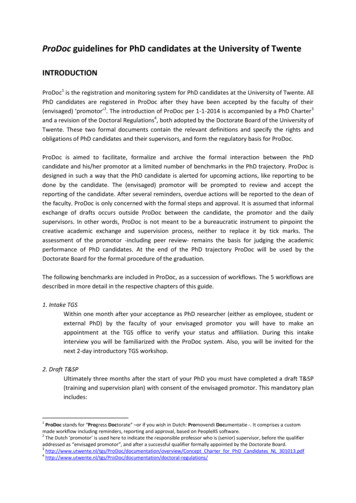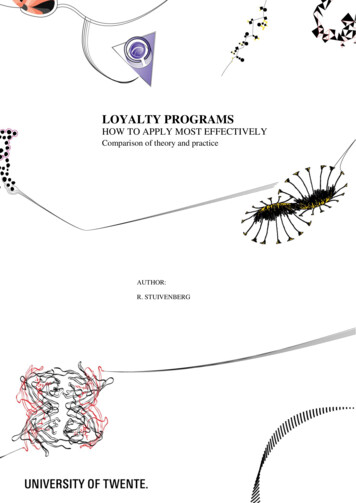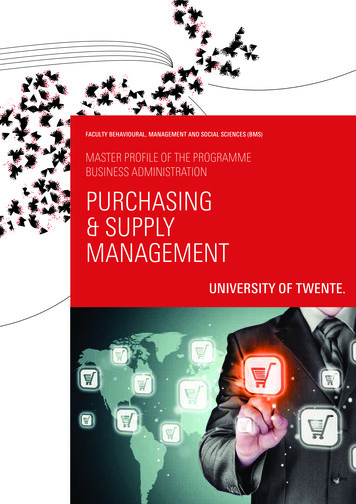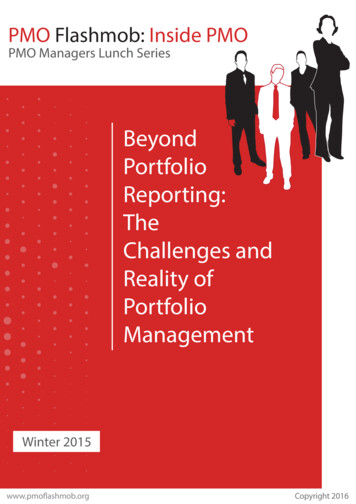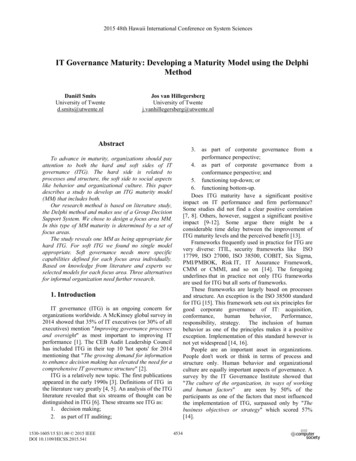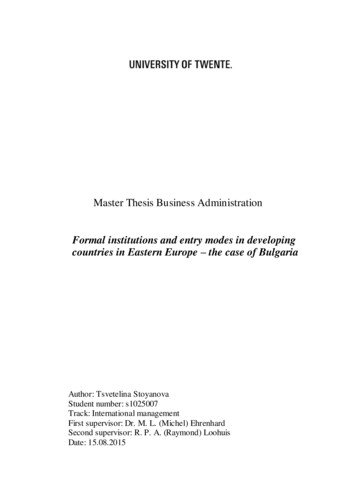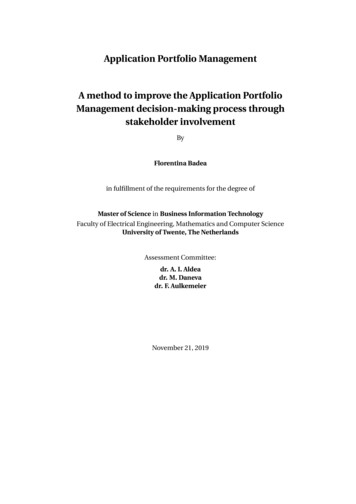
Transcription
Application Portfolio ManagementA method to improve the Application PortfolioManagement decision-making process throughstakeholder involvementByFlorentina Badeain fulfillment of the requirements for the degree ofMaster of Science in Business Information TechnologyFaculty of Electrical Engineering, Mathematics and Computer ScienceUniversity of Twente, The NetherlandsAssessment Committee:dr. A. I. Aldeadr. M. Danevadr. F. AulkemeierNovember 21, 2019
2Application Portfolio ManagementAbstractOrganizations struggle with historically grown application landscapes and the sharp increaseof their application portfolio complexity. The challenges faced with the application portfolio,lead to difficulties to respond quickly to the dynamic business changes and to conduct wellfounded decisions. This might be caused by a large amount of available data, limited supportfor decisive facts aggregation and the lack of a structured decision-making process. Thus, senior management bases their decisions on unreliable or incomplete information.Therefore, this master thesis focuses on the following challenges. First, there is a need for amethod that could help organizations improve their decision-making process. This issue isaddressed by integrating a data modeling approach and Application Portfolio Management(APM). The use of data-driven workflows and dashboards is expected to improve the APMdecision-making process by addressing the data complexity issue. Moreover, structured andtransparent decision-making requires a diversity of knowledge and perspectives. To addressthis, stakeholder involvement is seen as a necessary approach for identifying the stakeholdersand assess their needs throughout the process.This master thesis is expected to support organizations to improve their decisions regardingAPM by addressing the needs of the stakeholders involved in the process. The research aimsto develop a design method that helps organizations to achieve better decision-making capabilities to support their business objectives. This approach should enrich the collaborationbetween the stakeholders within an organization and provide them a personalized viewpointthat aligns their needs. Moreover, the goal of this research is to provide a better understanding of the data flow between the stakeholders and how it contributes to support the businessobjectives.This research can be considered a design science problem based on the definition byWieringa(2014), since the goal of this research is to solve a specific problem, the APM decisionmaking problem, by designing an artifact, the proposed method in Chapter 3. Therefore, asa design science research, this thesis will adopt the Design Science Research Methodology(DSRM) proposed by Peffers et al.(2007) to structure the chapters of this master thesis report.As a result of this research, the proposed method is expected to support organizations to improve their decisions regarding APM by addressing the needs of the stakeholders involved inthe process. The proposed method consists of six sequential steps that need to be carried out.Besides, several key attributes are identified, classified and operationalized for contributing toa thorough application inventory and a reporting capability for each of the stakeholders involved through the use of the data-driven workflows and dashboards.To conclude, some key findings from each chapter in this report is presented as follows: Chapter 2 answers questions relating to the state of the art for APM and available methods for the assessment of an application portfolio. It is found that the APM decisionmaking process can be enhanced by two important concepts, namely Enterprise Architecture (EA) and Data Modeling (DM). The main key findings in this chapter are the APMmethods and the information required throughout the process. Chapter 3 presents the development process of the proposed method. The key outcomeis the proposed method itself, along with detail steps and activities that must be followed. Chapter 4 describes the demonstration of the proposed method. It shows that the proposed method is applicable in an organizational setting and the APM decision-makingprocess can be improved if an EA model exists as well. Moreover, it demonstrates thatFlorentina BadeaUniversity of Twente
3stakeholder involvement is critical to the APM decision-making process and its implementation requires a strong commitment from the senior management. Chapter 5 presents the evaluation of the proposed method, along with the result of theevaluation workshop. The results show the most positive feedback for facilitating conditions, thus the participants are confident that they have the necessary knowledge to usethe method and the method is compatible with their organization. Overall, the methodis agreed to be helpful and expected to be used when addressing customer needs. Chapter 6 concludes this master thesis report followed by contributions for both theoryand practice, limitations, and possible future work. One of the limitations is this researchuses literature study and expert interviews as a foundation for assumptions regardingthe stakeholders. Thus, one of the future research discussed could focus on a real-lifecontext with an expanded selection of stakeholders. Furthermore, more attributes fromthe stakeholder analysis can be used for the customization of the dashboard design.Data Science and BusinessFlorentina Badea
4Application Portfolio ManagementAcknowledgementWriting my master thesis has been an emotional roller coaster and represented my biggest challenge. This challenge represented nothing less than an opportunity to grow and learn, and thecompletion of this master thesis report is proof of how badly I wanted to achieve my dream ofstudying abroad and how hard I was willing to work for it. Choosing to pursue this master’s atthe University of Twente (UT) has been my best decision and the overall experience was beyondmy expectations.I would like to thank my supervisors, Dr. Adina Ioana Aldea, as my first supervisor and Dr. MayaDaneva as my second supervisor, for their continuous support for this thesis, the feedback,and the guidance. Adina, thank you for encouraging me throughout the process, you’ve beenamazing and I cannot thank you enough. I would also like to thank BiZZdesign, especiallyto Fabian Aulkemeier and Dick Quartel, who gave me the opportunity to do my graduationproject, to improve my knowledge and to challenge myself.Through this experience, my mental health was also challenged. However, I am lucky enoughto be in an environment where people are there to inspire, support and empower you. I’ve beentold that storms are inevitable and whenever I found myself in one, instead of fighting it rightaway I need to find myself an anchor. I have found this anchor through my friends and family.Thank you for your continuous support, thousand messages and calls. I cannot imagine whoI would be without you, but honestly, I don’t want to know. You have significantly contributedto who I am today and I don’t have enough words to express that enough. Ioana, Andreeathank you for cheering me up and believing in me more than I could. Alexandra Zanfirescu,Alexandra Popescu, Dede, and Ioana, thank you for all your support and motivation memesyou’ve sent. Moreover, I would like to express my thanks to the UT marketing departmentand the International Student Team for becoming my second family here in the university andgiving me the opportunity to make the best of my experience here. I will always cherish all theadvice you’ve shared with me and I promise to always be a promoter of this university.To my best friend, Sugandh, you’ve been the MVP of my social life. Thank you for sharing yourculture, your food, for teaching me everything you could and helping me to get my confidenceback. You’ve been there for me whenever I needed you, and honestly, I lost count of the timeswhen that happened. I would also like to thank Ajinkya for his advice and for inspiring meto dream big. Arka, Jagdeesh and Sahil, you made my weekends the most amazing ones andyou’ve been my urban tribe from Enschede. Bart, you captured my best memories at this university and I am grateful for that. Lastly, I would like to thank Connecting Hands at the UT,especially Hamza, for giving me the opportunity to be part of such an amazing team, and toachieve my dream of getting More than a Degree.Finally, I would like to thank all my international friends and people that were part of my journey and shaped me into the person I’ve become. I am truly blessed.Florentina BadeaUniversity of Twente
5About BiZZdesignAccording to the Gartner Magic Quadrant for Enterprise Architecture tools 2017’, BiZZdesignstands out as a leader in this industry based on completeness of vision and ability to execute.Founded in 2001 by Henry Franken, Harmen van den Berg, and Harm Bakker, BiZZdesign is aDutch enterprise architecture and BPM software-development tools vendor and consultancycompany.Their position as a leader stands out as a result of their improved customer experience focuswhich brought the company a growing customer base and an expanding geographical coverage. Introducing a jointly owned and planned implementation roadmap with their customers,BiZZdesign empowers companies worldwide to drive simplicity, which is also their motto. Theysupport their customers by improving the quality and the speed of the decision-making process on their journey of continuous improvement and transformational changes.One of their most known products is BiZZdesign Enterprise Studio, a collaborative design platform, which provides powerful, integrated modeling across multiple disciplines. Through itscapabilities to plan, track and execute change in a single software platform it provides a highvalue for its users, especially for business management. Their latest product is HoriZZon, anonline platform offering a highly personalized environment, which provides real-time insightsin changing projects through the use of architecture models, business design capabilities andanalyses to a broad audience of business stakeholders. The main benefit is that it can supportthe improvement of the decision-making process by facilitating collaboration between business and IT teams and enabling a wide range of stakeholders to be informed about the currentstate of the enterprise.In this research, BiZZdesign Enterprise Studio supports the enterprise architecture modellingand creating the application inventory. Moreover, the metrics functionality helps the quantification and visualization of the analysis result through personalized dashboards. This researchinvestigates how the above-mentioned tools can be better used for creating capabilities to enrich Application Portfolio Management.Although BiZZdesign is a leader in the field of Enterprise Architecture, with a focus on modelingand management, their expertise covers also fields like business process management, portfolio management, business model and strategy, governance, risks and data management Thisresearch study focuses on Application Portfolio Management and investigates how EnterpriseArchitecture and Data Modeling can enrich its practice in enterprises.This research study aligns with BiZZdesign vision of building an adaptive enterprise that candeal with the opportunities and demands of a challenging business environment and their research interest in developing and improving software tools and methods that support stakeholders in their daily decision-making process.Data Science and BusinessFlorentina Badea
6Application Portfolio ManagementFlorentina BadeaUniversity of Twente
7Contents1 Introduction11.1 Problem Statement . . . . . . . . . . . . . . . . . . . . . . . . . . . . . . . . . . . . .31.2 Research Objective . . . . . . . . . . . . . . . . . . . . . . . . . . . . . . . . . . . . .41.3 Research Questions . . . . . . . . . . . . . . . . . . . . . . . . . . . . . . . . . . . . .41.4 Research Methodology . . . . . . . . . . . . . . . . . . . . . . . . . . . . . . . . . . .51.5 Research Structure . . . . . . . . . . . . . . . . . . . . . . . . . . . . . . . . . . . . .62 Literature Review82.1 Application Portfolio Management . . . . . . . . . . . . . . . . . . . . . . . . . . . .112.2 Stakeholder Involvement . . . . . . . . . . . . . . . . . . . . . . . . . . . . . . . . .272.3 Data Modeling and Visualization . . . . . . . . . . . . . . . . . . . . . . . . . . . . .352.4 Enterprise Architecture . . . . . . . . . . . . . . . . . . . . . . . . . . . . . . . . . .432.5 Relationship between the main concepts . . . . . . . . . . . . . . . . . . . . . . . .513 Design Method543.1 Identifying and classifying the stakeholders . . . . . . . . . . . . . . . . . . . . . .553.2 Defining process models . . . . . . . . . . . . . . . . . . . . . . . . . . . . . . . . . .573.3 Identifying and classifying metrics . . . . . . . . . . . . . . . . . . . . . . . . . . . .593.4 Defining metrics valuation . . . . . . . . . . . . . . . . . . . . . . . . . . . . . . . .613.5 Creating the data-driven workflows . . . . . . . . . . . . . . . . . . . . . . . . . . .623.6 Creating the dashboards . . . . . . . . . . . . . . . . . . . . . . . . . . . . . . . . . .633.7 Tool selection . . . . . . . . . . . . . . . . . . . . . . . . . . . . . . . . . . . . . . . .654 Case Demonstration684.1 Case Description . . . . . . . . . . . . . . . . . . . . . . . . . . . . . . . . . . . . . .684.2 Identifying and classifying the stakeholders . . . . . . . . . . . . . . . . . . . . . .694.3 Defining process models . . . . . . . . . . . . . . . . . . . . . . . . . . . . . . . . . .734.4 Identifying and classifying metrics . . . . . . . . . . . . . . . . . . . . . . . . . . . .764.5 Defining metrics Valuation . . . . . . . . . . . . . . . . . . . . . . . . . . . . . . . .794.6 Creating the data-driven workflows . . . . . . . . . . . . . . . . . . . . . . . . . . .804.7 Creating the dashboards . . . . . . . . . . . . . . . . . . . . . . . . . . . . . . . . . .835 Evaluation905.1 Survey . . . . . . . . . . . . . . . . . . . . . . . . . . . . . . . . . . . . . . . . . . . . .905.2 Workshop Result . . . . . . . . . . . . . . . . . . . . . . . . . . . . . . . . . . . . . .936 Conclusion996.1 Discussion . . . . . . . . . . . . . . . . . . . . . . . . . . . . . . . . . . . . . . . . . .Data Science and BusinessFlorentina Badea99
8Application Portfolio Management6.2 Contributions . . . . . . . . . . . . . . . . . . . . . . . . . . . . . . . . . . . . . . . . 1016.3 Limitations and Future Research . . . . . . . . . . . . . . . . . . . . . . . . . . . . . 102Bibliography104Appendix 1108.1Assessment Framework . . . . . . . . . . . . . . . . . . . . . . . . . . . . . . . . . . 108Appendix 2117.2UTAUT constructs (Venkatesh et al., 2003) . . . . . . . . . . . . . . . . . . . . . . . 118.3Evaluation survey . . . . . . . . . . . . . . . . . . . . . . . . . . . . . . . . . . . . . . 119.4Evaluation survey results . . . . . . . . . . . . . . . . . . . . . . . . . . . . . . . . . 124Florentina BadeaUniversity of Twente
11 IntroductionThe success of an organization is built upon its capability of adapting to the changing businessenvironment. Investments in information systems (IS) and information technology (IT) arebeing made to facilitate and improve their internal operational processes. Acquisitions and therapid growth have resulted in a complex IT portfolio that organizations struggle to manage fordelivering modernized, secured and cost-effective applications on time, on benefit and alignedto their business.IT is constantly driven to improve business agility, increase their response time to new demands and “do more with less”. This requires companies to remove inefficiencies in existingportfolios and better manage the portfolio applications that support key services and strategic projects. However, in most of the cases, the application landscape is poorly understood,leading to organizations storing redundant data and implementing similar features.In addition to that, executives find themselves in the position of deciding which are the bestsolutions or approaches to support their business goals. To meet this requirement, IT leadership requires complete visibility across their applications deployed in the enterprise, alongwith critical information, to increase their efficiency in the decision-making process.Application portfolio management (APM) supports businesses to achieve the required visibility to leverage their existing application portfolio and align technological assets with businessgoals, by taking into consideration the need and the value of the current application portfolio.A thorough definition of APM is given by Simon et al. (2010) and identifies APM as a structuredand continuous decision-making process intended to support the evaluation of an organization’s applications. This evaluation should include various perspectives so that stakeholdersgain appropriate knowledge to weigh various actions for future improvements and provide solutions for identified issues. The promise of APM lies primarily in reducing the complexity ofthe application landscape by having a holistic approach.Providing a holistic view, APM provides a launching pad for change. An application portfolioassessment yields directional and future recommendations, and aims to lead the organizationalong the best transformational path (Cognizant, 2014). To drive change in evolving businessscenarios, an Enterprise Architecture (EA) needs to be created, as it can play a pivotal role ofmanaging the application portfolio by tracking the organization’s transition and ensuring relevance with the changing business environment.Defined as a discipline for proactively and holistically leading enterprise responses to disruptive forces, EA identifies and analyzes the execution of change toward desired vision and outcomes (Gartner, 2017a). The signature-ready recommendations, such as road-maps, for adjusting policies and projects, are one significant contribution provided by EA for stakeholderswhich supports them to achieve target business outcomes that capitalize on relevant businessdisruptions. Moreover, an EA institutionalizes a governance model that enables change alongthe pathway by enforcing compliance with the plan and capturing core organizational values(Cognizant, 2014).The APM decision-making process requires accurate data and real-time access. Regularly updated data requires continual data entry, data integration, and error checking. This need forcontinuous data management places an extra burden on organizations. To address the continuous changes, new methods for tracking, comparing and archiving different versions of datashould be implemented to support the APM decision-making process.Moreover, since stakeholders often join the ongoing decision-making process at differentstages, a method is needed to consider the new contributions, while still allowing the impact ofData Science and BusinessFlorentina Badea
2Application Portfolio Managementthe process as a whole to be tracked. Therefore, to reduce delays, a strategy for managing largeamounts of updated data should be created for ongoing data entry, versioning, archiving anddocumentation.To address these issues, data-driven workflows are used for enriching the APM approach bysupporting the data collection process, the identification and the representation of how stakeholders collaborate and their impact on the data flow.Leading to a foundation that can complete broad-scope initiatives, an improved data qualityand a high-end view over its processing contribute to lowering the support cost and increasethe reusability opportunities, thereby reducing the costs of building new applications.Moreover, the use of the data-driven workflows supports creating the data models, used tocommunicate data requirements from business to IT and within IT from other stakeholdersof the organization. In addition to that, combining various data sources provides an opportunity to create scalable, flexible and tailored analytics over the key performance indicators.Therefore, common challenges faced when implementing an APM, like outdated data, lack ofresponsibility for data changes or inconsistency in data can be addressed, leading to the improvement of the decision-making process (Fabrice Vila, 2012).The challenges faced with the application portfolio, such as the increased size and complexity, lead to difficulties to respond quickly to the dynamic business changes (Cognizant, 2011)and to conduct well-founded decisions (Khosroshahi et al., 2016). The findings of Riempp andGieffers-Ankel (2007) indicate the unfounded and speculative decisions as a common struggle, caused by the flood of information and the limited support for decisive facts aggregation.Another research study strengthens the same idea by indicating the general lack of a permanent approach to the application landscape that draws on structured and rational methods formaking decisions about application investments on a portfolio-wide basis(Simon et al., 2010).The stakeholders’ involvement has been regarded as being an important practice (Riempp andGieffers-Ankel, 2007; Cantor, 2011; Khosroshahi et al., 2016). Their contribution to the decisionmaking process is required for data collection (Cantor, 2011), evaluation and analysis (Weilland Vitale, 1999).However, research dealing with APM is mostly dedicated to how to assess the health of a portfolio, how to classify applications and initiatives to improve the application landscape (Zelt et al.,2013a). Little or no attention is being given to the stakeholders and their needs throughout theAPM decision making process(Riempp and Gieffers-Ankel, 2007).Thus, there is a need for research on identifying the stakeholder needs in the APM decisionmaking process and how to support them. Under this consideration, the main aim of this thesisis to investigate the stakeholders, their needs for taking decisions related to APM and the toolsthat can support them.Integrating different perspectives could help organizations facilitate relevant decision makingby allowing access to important information by taking into account the entire range of constraints.Therefore, for developing an environment where relevant stakeholders can have real-time access to the information they need and collaborate, the assessment of both capabilities and theneeds of the main stakeholders for APM will be integrated along with the adoption of someanalytical tools to perform the assessment.This chapter aims at providing background information and the motivation for conducting thisresearch. Section 1.1 provides an overview of the problem statement that leads to conductingthis research, followed by the research objective in Section 1.2. The research questions are formulated subsequently in Section 1.3 as the foundation of this study. The research methodologyis presented in Section 1.4.Florentina BadeaUniversity of Twente
1. INTRODUCTION31.1 Problem StatementNowadays, companies struggle with historically grown application landscapes that are burdened with obsolete IT systems, unfinished or long-lasting applications that no longer meet thebusiness requirements (Zelt et al., 2013b). More than maintaining their applications which arefundamental for their business(Smith and McKeen, 2003), companies are also trying to prioritize their investments to drive operational efficiency and minimize the costs with maintenance(Cognizant, 2011).Complex application landscapes require a comprehensive portfolio understanding of the inherent relationships and dependencies between applications (Zelt et al., 2013b). APM has,therefore, become an important issue in the enterprise IT’s strategy (Sun et al., 2016), aiming to reduce the complexity of the application landscape, such as its heterogeneity, lack oftransparency and vast scope (Simon et al., 2010; Khosroshahi et al., 2016).Having as a main goal to reduce the application portfolio complexity through simplificationand harmonization, APM aims at managing the application portfolio as a business (Simonet al., 2010) and relies on understanding application compatibility with business priorities,strategies and processes (Kotani and Iijima, 2008). Moreover, it is also focusing on gainingknowledge about the data types that exist across the organization and their source (Erwin,2017). The gathered information provides a starting point for identifying problems and opportunities for better coverage of the business needs (Weill and Vitale, 1999).In the past, business strategies were focused on good management of their assets and limitations in the present, such as constraint management and resource allocation optimization.Nowadays, strategies focus on future business planning, such as payoff maximization andchoice of execution timing, where the progress can be measured through well-defined systemsdue to the emerging IT services. Therefore, developing and implementing an effective APM requires significant attention from the senior management to ensure success (Kotani and Iijima,2008).Recent studies reveal that the complexity of APM and the application clutter overwhelms thesenior management in the decision-making process (Kotani and Iijima, 2008; Simon et al.,2010; Schneider et al., 2015; McKeen and Smith, 2010). Most of their decisions are based on unreliable or incomplete information (Simon et al., 2010) and sometimes the data is unavailableor outdated (Planview, 2015). Project managers usually depend on people to respond to theoutputs and benefits that they deliver, however, the responses are not always offered (Erwin,2017). This is mainly caused by the fact the team members are not engaged and held accountable (Planview, 2015). To address this issue, senior management must change the decisionmaking process (Zelt et al., 2013b).A recent study states that although IT professionals have the necessary knowledge about the existing connections across applications and data, their perspectives are not considered duringthe strategy discussions and the decision-making process (Erwin, 2017). Organization stakeholders are defined as “any group or individuals who can affect or is affected by the achievement of the organization’s objectives” and a change towards a stakeholder viewpoint is demonstrated to improve the efficiency of an APM (Simon et al., 2010).In the last decade, grey literature recommends the stakeholders’ involvement as a best practicefor assuring data consistency in APM related decisions (Erwin, 2017; Fabrice Vila, 2012; Cognizant, 2014). Nevertheless, most of the existing academic papers regarding APM take a technical approach, focusing on the metrics and the analytics that can be deployed (Khosroshahiet al., 2016; Kotani and Iijima, 2008; Zelt et al., 2013b).The most effective APM solutions can deliver value with sets of significant data based on theneeds of the stakeholders. Thus, it becomes critical to have an overview of the data requiredData Science and BusinessFlorentina Badea
4Application Portfolio Managementto satisfy their needs and support them to achieve the business goals through well-informeddecisions. Moreover, stakeholders need to perceive the data as being trustworthy so they canuse it in their daily routine for decision making, therefore data ownership is also important.Taken into consideration the aforementioned statements, stakeholder involvement can arguably be considered the most important factor for developing and implementing an effectiveAPM, and it should not be regarded as a trimming activity.Hence, the purpose of this research is to articulate a method for an APM solution to help organizations improve their decision-making process. The input for the proposed design will bederived by identifying the stakeholders and their needs and creating a data structure modelthat will reinforce their experience. The output should enable improvement for the decisionmaking process.1.2 Research ObjectiveThe research aims to develop a design method that integrates a data modeling approach andAPM, to help organizations to achieve better decision-making capabilities to support theirbusiness objectives. This approach should enrich the collaboration between the stakeholderswithin an organization and provide them a personalized viewpoint that aligns their needs.Moreover, the goal of this research is to provide a better understanding of the data flow betweenthe stakeholders and how it contributes to support the business objectives. To achieve theabove-mentioned objectives, the following steps are taken to create the designed method basedon stakeholders needs: Conduct a literature review regarding the APM practice and the opportunities to enrichit through EA and by using data-driven workflows Mapping the stakeholders needs with data and the architecture capabilities Develop the data-driven workflows Apply the proposed data workflows to a case study Evaluate the conceptual model Discuss the limitations, further research, recommendation, and the results1.3 Research QuestionsThis subsection will present the research questions for this thesis. The main research questionwill be explained in the first subsection, while the sub research questions will be explainedsubsequently in the next subsection.1.3.1 Main Research QuestionBased on the problem statement and the objective of the thesis, the main research question isformulated as follows:“How can the APM decision-making process better support different stakeholder needswith the help of data-driven workflows?”1.3.2 Sub Research QuestionsThe following sub-questions are formulated to offer background knowledge for answering themain research question:1. What is the state of art in Application Portfolio Management (APM)?Florentina BadeaUniversity of Twente
1. INTRODUCTION52. What kind of methods are available for the assessment
2 Application Portfolio Management Abstract Organizations struggle with historically grown application landscapes and the sharp increase of their application portfolio complexity. The challenges faced with the application portfolio, lead to difficulties to respond quickly to the dynamic business changes and to conduct well-founded decisions.
